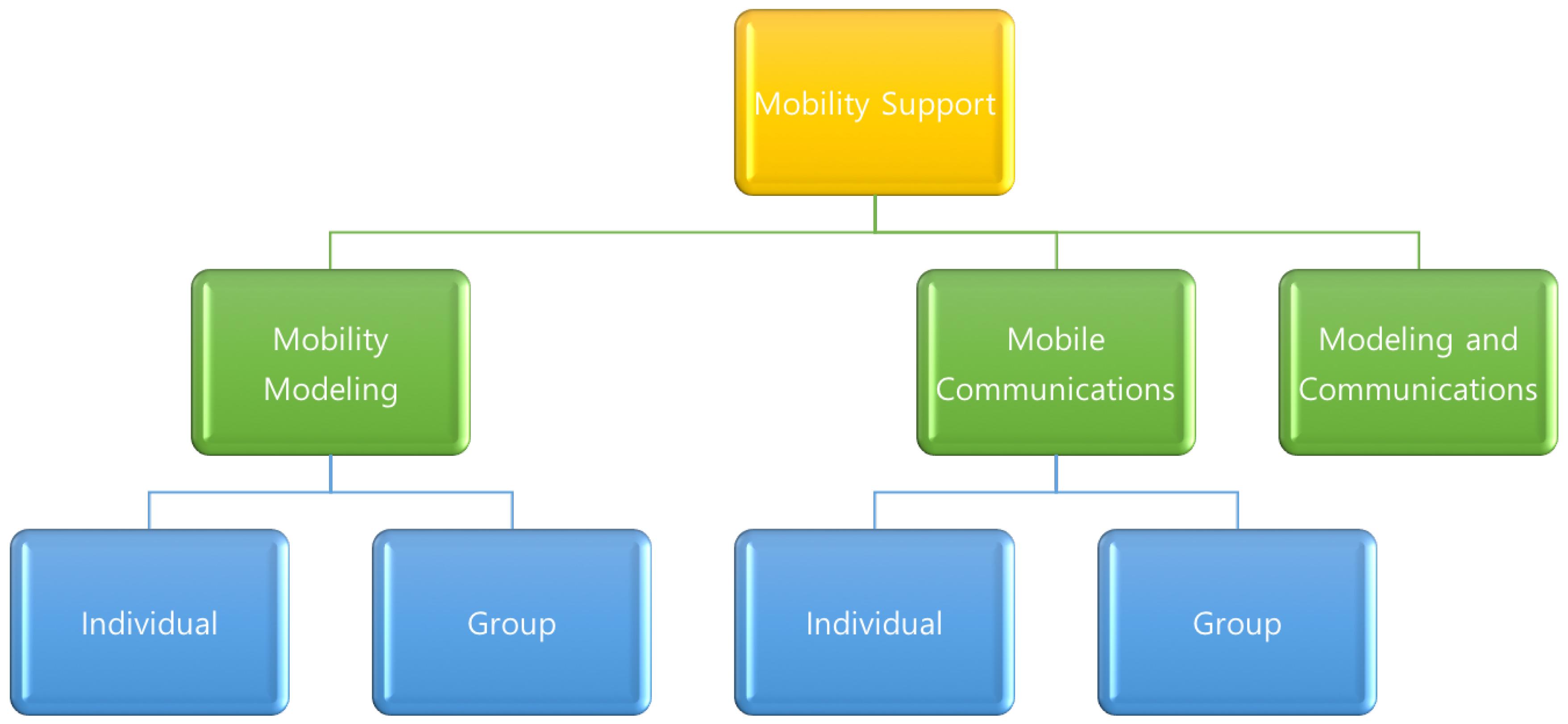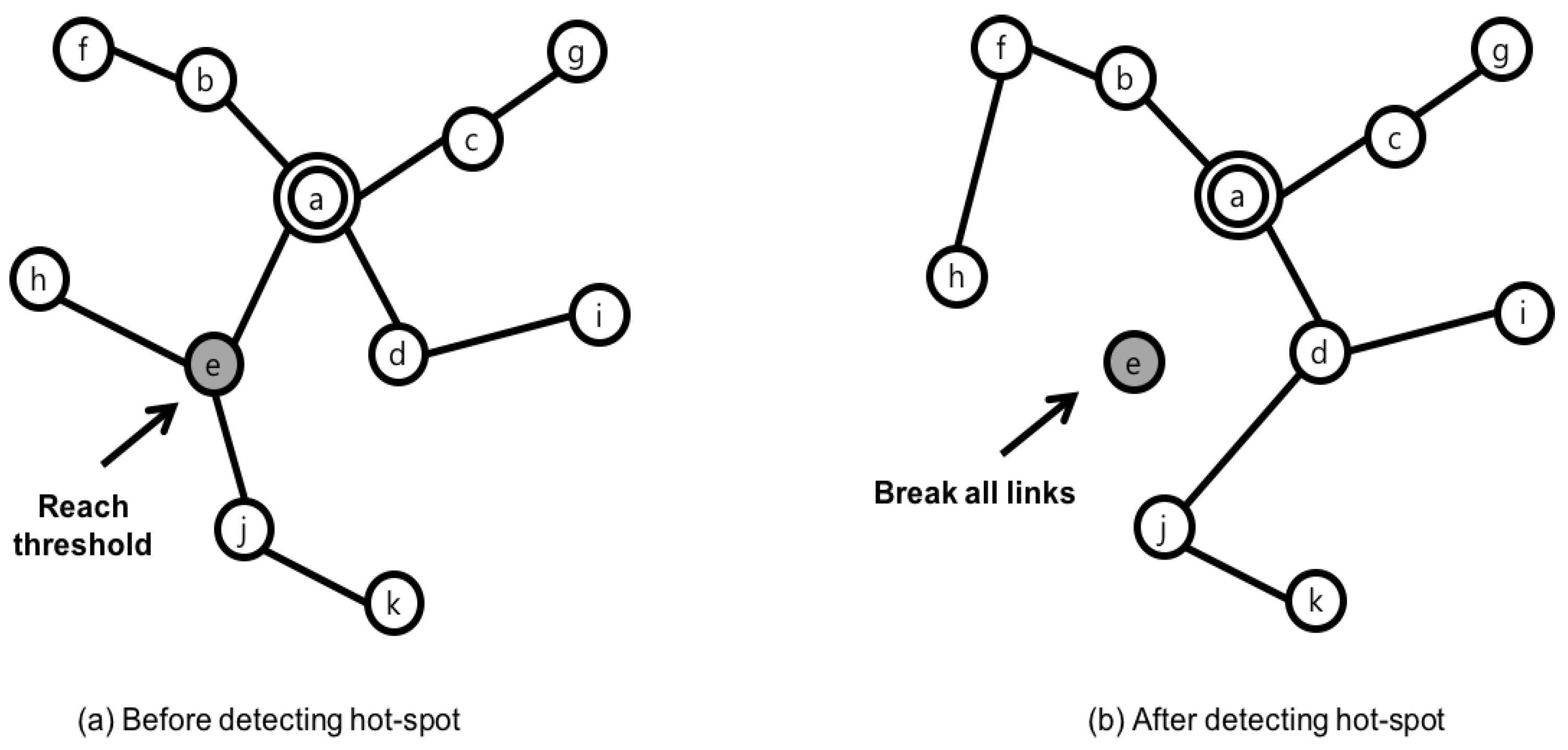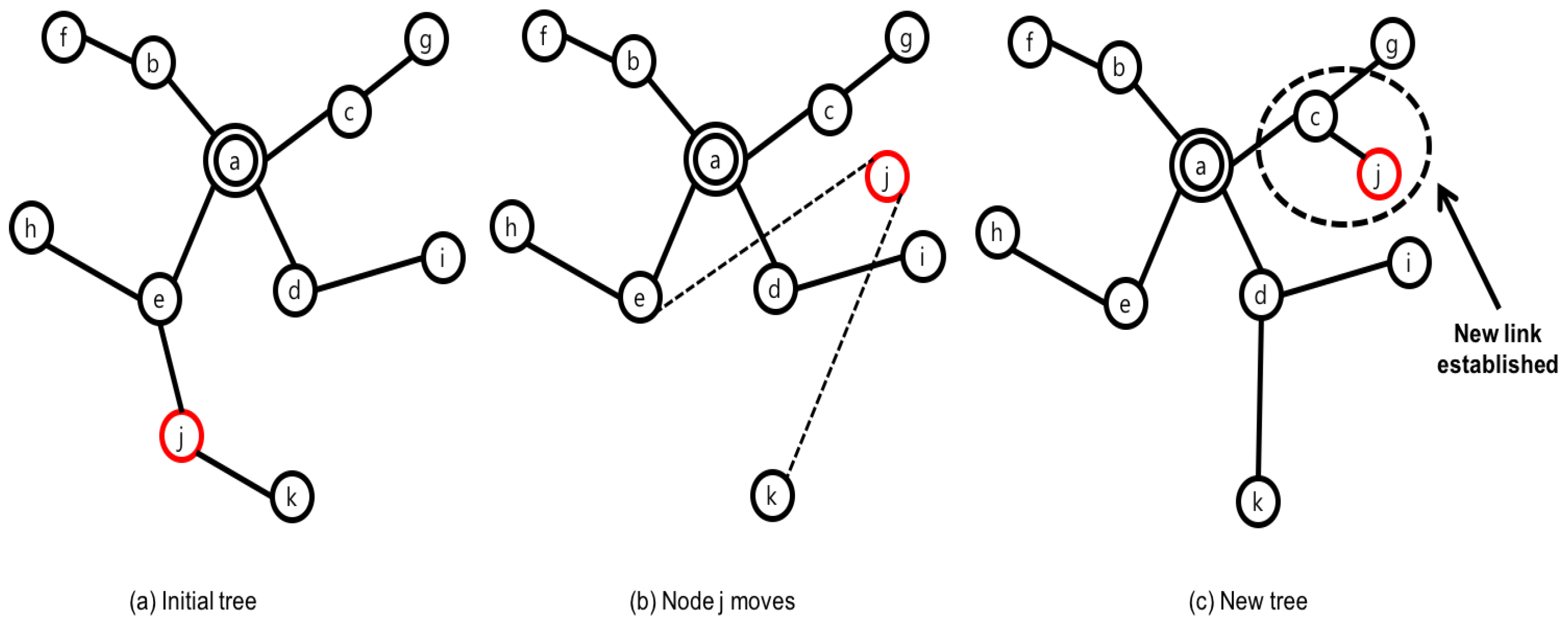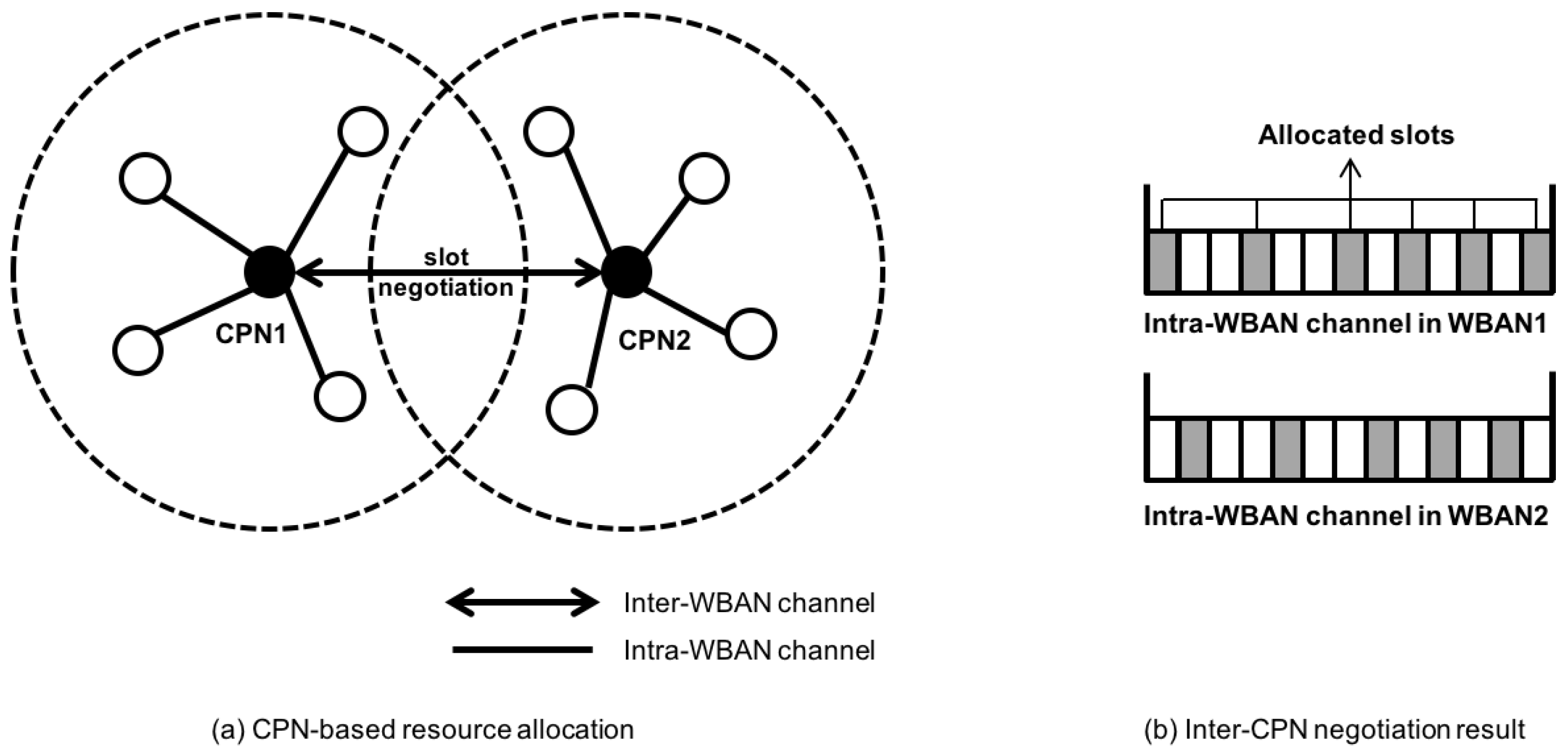A Survey on Mobility Support in Wireless Body Area Networks
Abstract
:1. Introduction
2. Mobility Support in WBANs
3. Mobility Model and Communication Protocol
3.1. Individual Mobility
3.1.1. Mobility Model
3.1.2. Protocols for General Mobility
3.1.3. Protocols for Specific Mobility
3.2. Group Mobility
3.2.1. Mobility Model
3.2.2. Protocols for General Mobility
3.2.3. Protocols for Specific Mobility
4. Open Issues
- Mobility Model for Network Simulator: most of the research works for WBAN include performance evaluation results to prove their suitability through simulation. The mobility model is very important and plays a significant role in evaluating the performance. This indicates that the mobility model should be operated with a network simulator in a cooperative way. Currently, OMNeT++ and NS-2/3 are general frameworks to conduct simulation for WBAN. Therefore, it is demanded to get a free, available WBAN mobility model as an add-on for these frameworks. To meet this requirement, mobility generating tools and analysis tools such as BonnMotion (University of Osnabrück, Osnabrück, Germany) [54] are essential for the mobility model. Furthermore, its analysis should be done to prove the accuracy of the mobility model.
- Various Mobility Models: Generally, the mobility model is designed to explain the movement pattern of mobile nodes and how their locations change over time according to velocity and direction. Thus, it is desirable for mobility models to emulate the movement pattern of targeted real-life applications in a feasible way. Even though a few applications are now available and deployable nowadays, current mobility models are not enough to describe movement of nodes accurately. Therefore, further research for human behavior is required to enhance mobility models.In addition, current mobility models do not take external environments, such as roads in the city for walking and running postures into account; therefore, a combination of several mobility models that describe the moving boundary contributes to improvement of accuracy. One of the candidates is the Manhattan model. In addition, since human behavior is affected by the different situations such as age and living place, they should be taken into account for mobility design.
- Integration with External System: one of the best sources to develop mobility patterns is to collect traces. If we have any device to track all movements in an efficient way, this will be the best option to get traces. Recently, smartphones have become pervasive so research work for smartphone-based human mobility prediction has been initiated. As Do et al. [55] proposed, it will be a good way to make use of smartphones to predict the movement and develop the mobility models. This is a reason to integrate mobility models with external systems. In addition, WSN, infrastructure for vehicular ad hoc networks and mobile networks can be good sources to collect human mobility, especially for group mobility. Therefore, interfaces to get the demanded information with external systems can accelerate the mobility model research.
- Network Architecture: Current research work is assumed under homogenous as well as flat network architecture. However, recent routing protocol gradually takes clustering or hierarchical architecture into account as observed in [56]. To catch up with this trend, mobility support should be designed to operate under heterogeneous networks architecture. In this architecture, different mobility patterns need to be applied according to types of nodes. In addition, mobility relationships between two types of nodes is required to integrate them into a system.
- Security: Contrary to benefitting from external systems, security is one of the important research challenges in WBAN. Furthermore, mobility results in more critical tasks for security because new authentication may be required to new topology, especially in the case of handovers. More seriously, when it comes to additional overhead to handle mobility, it leads to uncertainty of security support on a resource constrained node.
5. Conclusions
Acknowledgments
Author Contributions
Conflicts of Interest
References
- Malik, B.; Singh, V. A survey of research in WBAN for biomedical and scientific applications. Health Technol. 2013, 3, 227–235. [Google Scholar] [CrossRef]
- Filipe, L.; Fdez-Riverola, F.; Costa, N.; Pereira, A. Wireless body area networks for healthcare applications: Protocol stack review. Int. J. Distrib. Sens. Netw. 2015, 2015. [Google Scholar] [CrossRef]
- Negraa, R.; Jemilia, I.; Belghitha, A. Wireless body area networks: Applications and technologies. Procedia Comput. Sci. 2016, 83, 1274–1281. [Google Scholar] [CrossRef]
- Fortino, G.; Giannantonio, R.; Gravina, R.; Kuryloski, P.; Jafari, R. Enabling Effective Programming and Flexible Management of Efficient Body Sensor Network Applications. IEEE Trans. Hum-Mach. Syst. 2013, 43, 115–133. [Google Scholar] [CrossRef]
- Augimeri, A.; Fortino, G.; Galzarano, S.; Gravina, R. Collaborative Body Sensor Networks. In Proceedings of the IEEE International Conference on Systems, Man, and Cybernetics, Anchorage, AK, USA, 9–12 October 2011; pp. 3427–3432. [Google Scholar]
- Chen, M.; Gonzalez, S.; Vasilakos, A.; Cao, H.; Leung, V. Body area networks: A survey. Mob. Netw. Appl. 2011, 16, 171–193. [Google Scholar] [CrossRef]
- Movassaghi, S.; Abolhasan, M.; Lipman, J.; Smith, D.; Jamalipour, A. Wireless body area networks: A survey. IEEE Commun. Surv. Tutor. 2014, 16, 1658–1686. [Google Scholar] [CrossRef]
- Cavallari, R.; Martelli, F.; Rosini, R.; Buratti, C.; Verdone, R. A survey on wireless body area networks: Technologies and design challenges. IEEE Commun. Surv. Tutor. 2014, 16, 1635–1657. [Google Scholar] [CrossRef]
- Ghamari, M.; Janko, B.; Sherratt, R.; Harwin, W.; Piechockic, R.; Soltanpur, C. A survey on wireless body area networks for eHealthcare systems in residential environments. Sensors 2016, 16, 831. [Google Scholar] [CrossRef] [PubMed]
- Gravina, R.; Alinia, P.; Ghasemzadeh, H.; Fortino, G. Multi-sensor fusion in body sensor networks: State-of-the-art and research challenges. Inf. Fusion 2017, 35, 68–80. [Google Scholar] [CrossRef]
- Fortinoa, G.; Galzarano, S.; Gravina, R.; Li, W. A framework for collaborative computing and multi-sensor data fusion in body sensor networks. Inf. Fusion 2015, 22, 50–70. [Google Scholar] [CrossRef]
- Imrana, M.; Alnuem, M.; Fayed, M.; Alamri, A. Localized algorithm for segregation of critical/non-critical nodes in mobile ad hoc and sensor networks. Procedia Comput. Sci. 2013, 19, 1167–1172. [Google Scholar] [CrossRef]
- Imran, M.; Said, A.; Younis, M.; Hasbullah, M. Application-centric recovery algorithm for wireless sensor and actor networks. Int. J. Commun. Netw. Distrib. Syst. 2013, 10, 379–401. [Google Scholar] [CrossRef]
- Camp, T.; Boleng, J.; Davies, V. A survey of mobility models for ad hoc network research. Wirel. Commun. Mob. Comput. 2002, 2, 483–502. [Google Scholar] [CrossRef]
- Liang, B.; Haas, Z. Predictive distance-based mobility management for PCS networks. In Proceedings of the Eighteenth IEEE Annual Joint Conference of the IEEE Computer and Communications Societies, New York, NY, USA, 21–25 March 1999; pp. 1377–1384. [Google Scholar]
- Sandhu, M.; Javaid, N.; Jamil, M.; Khan, Z.; Imran, M.; Ilahi, M.; Khan, M. Modeling mobility and psychological stress based human postural changes in wireless body area networks. Comput. Hum. Behav. 2015, 15, 1042–1053. [Google Scholar] [CrossRef]
- Quwaider, M.; Biswas, S. On-body packet routing algorithms for body sensor networks. In Proceedings of the First International Conference on Networks and Communications, Chennai, India, 27–29 December 2009; pp. 171–177. [Google Scholar]
- Quwaider, M.; Biswas, S. Probabilistic routing in on-body sensor networks with postural disconnections. In Proceedings of the 7th ACM International Symposium on Mobility Management and Wireless Access, Tenerife, Canary Islands, Spain, 26–27 October 2009; pp. 149–158. [Google Scholar]
- Quwaider, M.; Biswas, S. DTN routing in body sensor networks with dynamic postural partitioning. Ad Hoc Netw. 2010, 8, 824–841. [Google Scholar] [CrossRef] [PubMed]
- Maskooki, A.; Soh, C.; Gunawan, E.; Low, K. Opportunistic routing for body area network. In Proceedings of the IEEE Consumer Communications and Networking Conference, Las Vegas, NV, USA, 9–12 January 2011. [Google Scholar]
- Azhari, M.; Toumanari, A.; Latif, R.; Moussaid, N. Relay based thermal aware and mobility support routing protocol for wireless body sensor networks. Int. J. Commun. Netw. Inf. Secur. 2016, 8, 64–73. [Google Scholar]
- Liang, X.; Li, X.; Shen, Q.; Lu, R.; Lin, X.; Shen, X.; Zhuang, W. Exploiting prediction to enable secure and reliable routing in wireless body area networks. In Proceedings of the 21st IEEE International Conference on Computer Communications, Munchen, Germany, 30 July–2 August 2012; pp. 388–396. [Google Scholar]
- Movassaghi, S.; Abolhasan, M.; Lipman, J. Energy efficient thermal and power aware (ETPA) routing in body area networks. In Proceedings of the IEEE 23rd International Symposium on Personal Indoor and Mobile Radio Communications, Sydney, Australia, 9–12 September 2012; pp. 1108–1113. [Google Scholar]
- Javaida, N.; Abbas, Z.; Fareed, M.; Khan, Z.; Alrajeh, N. M-ATTEMPT: A new energy-efficient routing protocol for wreless body area networks. Procedia Comput. Sci. 2013, 19, 224–231. [Google Scholar] [CrossRef]
- Javaida, N.; Ahmad, A.; Nadeem, Q.; Imran, M.; Haider, N. IM-SIMPLE: Improved stable increased- throughput multi-hop link efficient routing protocol for wireless body area networks. Comput. Hum. Behav. 2015, 51, 1003–1011. [Google Scholar] [CrossRef]
- Sandhu, M.; Javaid, N.; Akbar, M.; Najeeb, F.; Qasim, U.; Khan, Z. FEEL: forwarding data energy efficiently with load balancing in wireless body area networks. In Proceedings of the 28th IEEE International Conference on Advanced Information Networking and Applications, Victoria, BC, Canada, 13–16 May 2014. [Google Scholar]
- Kim, B.; Kang, S.; Lim, J.; Kim, K.; Kim, K. A mobility-based temperature-aware routing protocol for wireless body sensor networks. In Proceedings of the 31st International Conference on Information Networking, Da Nang, Vietnam, 11–13 January 2017. [Google Scholar]
- Yousaf, S.; Akbar, M.; Javaid, N.; Iqba, A.; Khan, Z.; Qasim, U. CEMob: Critical data transmission in emergency with mobility support in WBANs. In Proceedings of the IEEE 28th International Conference on Advanced Information Networking and Applications, Victoria, BC, Canada, 13–16 May 2014. [Google Scholar]
- Lin, C.; Lin, K.; Chen, W. Rate adaptation for highly dynamic body area networks. In Proceedings of the IEEE International Conference on Internet of Things, and IEEE Green Computing and Communications and IEEE Cyber, Physical and Social Computing, Taipei, Taiwan, 1–3 September 2014. [Google Scholar]
- Sahndhu, M.; Javaid, M.; Imran, M.; Guizani, M.; Khan, Z.; Qasim, U. BEC: A novel routing protocol for balanced energy consumption in Wireless Body Area Networks. In Proceedings of the International Wireless Communications and Mobile Computing Conference, Dubrovnik, Croatia, 24–28 August 2015. [Google Scholar]
- Smail, O.; Kerrar, A.; Zetili, Y.; Cousin, B. ESR: Energy aware and stable routing protocol for WBAN networks. In Proceedings of the 12th International Wireless Communications and Mobile Computing Conference, Paphos, Cyprus, 5–9 September 2016. [Google Scholar]
- Ahmed, S.; Javaid, N.; Yousaf, S.; Ahmad, A.; Sandhu, M.; Imran, M.; Khan, Z.; Alrajeh, N. Co-LAEEBA: Cooperative link aware and energy efficient protocol for wireless body area networks. Comput. Hum. Behav. 2015, 51, 1205–1215. [Google Scholar] [CrossRef]
- Adhikary, S.; Choudhury, S.; Chattopadhyay, S. A new routing protocol for WBAN to enhance energy consumption and network lifetime. In Proceedings of the International Conference on Distributed Computing and Networking, Hyderabad, India, 4–7 January 2017. [Google Scholar]
- Lewis, D. 802.15.6 Call for Applications—Response Summary; IEEE 802.15 Working Group Document; 2008. [Google Scholar]
- Birgani, Y.; Javan, N.; Tourani, M. Mobility enhancement of patients body monitoring based on WBAN with multipath routing. In Proceedings of the 2014 2nd International Conference on Information and Communication Technology, Bandung, Indonesia, 28–30 May 2014. [Google Scholar]
- Braem, B.; Blondia, C. Supporting mobility in wireless body area networks: An analysis. In Proceedings of the 18th IEEE Symposium on Communications and Vehicular Technology in the Benelux, Ghent, Belgium, 22–23 November 2011. [Google Scholar]
- Roy, R. Reference Point Group Mobility. In Handbook of Mobile Ad Hoc Networks for Mobility Models; Springer: New York, NY, USA, 2010; pp. 637–670. [Google Scholar]
- Sanchez, M.; Manzoni, P. ANEJOS: A java based simulator for ad hoc networks. Future Gener. Comput. Syst. 2001, 17, 573–583. [Google Scholar] [CrossRef]
- Mei, A.; Stefa, J. SWIM: A simple model to generate small mobile worlds. In Proceedings of the IEEE Conference on Computer Communications, Rio de Janeiro, Brazil, 19–25 April 2009; pp. 855–863. [Google Scholar]
- Zhao, C.; Sichitiu, M. N-Body: Social based mobility model for wireless ad hoc network research. In Proceedings of the 7th IEEE Communications Society Conference on Sensor, Mesh and Ad Hoc Communications and Networks, Boston, MA, USA, 21–25 June 2010; pp. 1–9. [Google Scholar]
- Nabi, M.; Geilen, M.; Basten, T. MoBAN: A configurable mobility model for wireless body area networks. In Proceedings of the 4th International ICST Conference on Simulation Tools and Techniques, Barcelona, Spain, 22–24 March 2011; pp. 168–177. [Google Scholar]
- Misra, S.; Mahapatro, J.; Mahadevappa, M.; Islam, N. Random room mobility model and extra-wireless body area network communication in hospital buildings. IET Netw. 2015, 4, 54–64. [Google Scholar] [CrossRef]
- Nardis, L.; Domenicali, D.; Benedetto, M. Mobility model for body area networks of soccer players. In Proceedings of the European Wireless Technology Conference, Paris, France, 27–28 September 2010. [Google Scholar]
- Cheng, S.; Huang, C.; Tu, C. RACOON: A multiuser QoS design for mobile wireless body area networks. J. Med. Syst. 2011, 35, 1277–1287. [Google Scholar] [CrossRef] [PubMed]
- Smart, G.; Deligiannis, N.; Surace, R.; Loscri, V.; Fortino, G.; Andreopoulos, Y. Decentralized time-synchronized channel swapping for ad hoc wireless networks. IEEE Trans. Veh. Technol. 2016, 65, 8538–8553. [Google Scholar] [CrossRef]
- Manirabona, A.; Boudjit, S.; Fourati, L. Energy aware routing protocol for inter WBANs cooperative Communication. In Proceedings of the ISNCC 2015: 2015 International Symposium on Networks, Computers and Communications, Yasmine Hammamet, Tunisia, 13–15 May 2015. [Google Scholar]
- Caldeira, J.; Rodrigues, J.; Lorenz, P. Intra-mobility support solutions for healthcare wireless sensor networks-handover issues. IEEE Sens. J. 2013, 11, 4339–4348. [Google Scholar] [CrossRef]
- Chen, Y. Mobility handoff mechanism for body area sensor networks on healthcare. Int. J. Eng. Invent. 2013, 2, 21–24. [Google Scholar]
- Li, J.; Cho, K.; Yoon, M.; Han, J.; Shu, Q.; Han, K. A mobility management solution to support personal mobile station in wireless body mesh networks. In Proceedings of the International Conference on Microwave and Optoelectronics, Belem, Brazil, 3–6 November 2009. [Google Scholar]
- Movassgaghi, S.; Majidloo, A.; Smith, D.; Abolhasan, M.; Jamalipou, A. Exploiting unknown dynamics in communications amongst coexisting wireless body area networks. In Proceedings of the IEEE Global Communications Conference, San Diego, CA, USA, 6–10 December 2015. [Google Scholar]
- Akram, S.; Javaid, N.; Ahmad, A.; Khan, Z.; Imran, M.; Guizani, M.; Hayat, A.; Ilahi, M. A fatigue measuring protocol for wireless body area sensor networks. J. Med. Syst. 2015, 39. [Google Scholar] [CrossRef] [PubMed]
- Javaid, N.; Ahmad, A.; Tauqir, A.; Imran, M.; Guizani, M.; Khan, Z.; Qasim, U. Modeling induction and routing to monitor hospitalized patients in multi-hop mobility-aware body area sensor networks. EURASIP J. Wirel. Commun. Netw. 2016, 2016. [Google Scholar] [CrossRef]
- Rathee, D.; Rangi, S.; Chakarvarti, S.; Singh, V. Recent trends in wireless body area network (WBAN) research and cognition based adaptive WBAN architecture for healthcare. Health Technol. 2014, 4, 239–244. [Google Scholar] [CrossRef]
- BonnMotion: A Mobility Scenario Generation and Analysis Tool. Available online: http://sys.cs.uos.de/bonnmotion/ (accessed on 20 January 2017).
- Do, T.; Gatica-Perez, D. Contextual conditional models for smartphone-based human mobility prediction. In Proceedings of the ACM Conference on Ubiquitous Computing, Pittsburgh, PA, USA, 5–8 September 2012; pp. 163–172. [Google Scholar]
- Verma, M.; Rai, R. Energy-efficient cluster-based mechanism for WBAN communications for healthcare applications. Int. J. Comput. Appl. 2015, 120, 24–31. [Google Scholar] [CrossRef]








| Protocol | Basic Principle | New Metric or Architecture | Underlying Technology | Target Performance Parameter |
|---|---|---|---|---|
| OBSFR | Store and forward | Distance to the sink | Flooding | Delay |
| PRPLC | Store and forward | Link Likelyhood Factor | Delay | |
| DVRPLC | Store and forward | Link Cost Factor | Delay | |
| ETPA | Store and forward | Cost of transmission to neighbor | Energy and temperature | |
| Opportunity Routing | Store and forward | Relay node | RTS/ACK | Energy |
| RTM-RP | Store and forward | Relay node | CSMA, TDMA | Energy and temperature |
| M-ATTEMPT | Store and forward | Heterogeneous | TDMA | Energy and delivery ratio |
| MTR | Store and carry | Meeting probability with sink node | Temperature |
© 2017 by the authors. Licensee MDPI, Basel, Switzerland. This article is an open access article distributed under the terms and conditions of the Creative Commons Attribution (CC BY) license (http://creativecommons.org/licenses/by/4.0/).
Share and Cite
Kim, B.-S.; Kim, K.H.; Kim, K.-I. A Survey on Mobility Support in Wireless Body Area Networks. Sensors 2017, 17, 797. https://doi.org/10.3390/s17040797
Kim B-S, Kim KH, Kim K-I. A Survey on Mobility Support in Wireless Body Area Networks. Sensors. 2017; 17(4):797. https://doi.org/10.3390/s17040797
Chicago/Turabian StyleKim, Beom-Su, Kyong Hoon Kim, and Ki-Il Kim. 2017. "A Survey on Mobility Support in Wireless Body Area Networks" Sensors 17, no. 4: 797. https://doi.org/10.3390/s17040797





